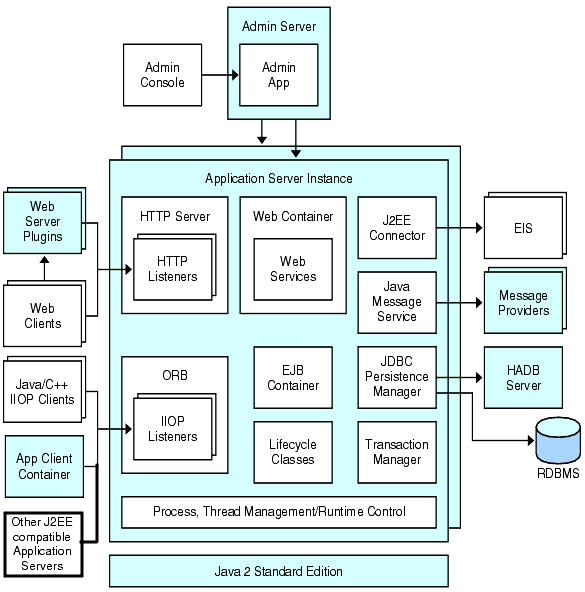Server Instance
The server instance is a single Java EE compatible Java Virtual Machine hosting an Enterprise Server on a single node. Each server instance has a unique name in the domain. A clustered server instance is a member of a cluster and receives all of its applications, resources, and configuration from its parent cluster; ensuring that all instances in the cluster are homogeneous. An unclustered server instance does not belong to a cluster and as such has an independent set of applications, resources, and configuration. The following figure shows an application server instance in detail. The application server instance is a building block in the clustering, load balancing, and session persistence features of the Enterprise Server.
Figure 1–1 Enterprise Server Instance

The Sun GlassFish Enterprise Server creates one application server instance, called server, at the time of installation. For many users, one application server instance meets their needs. However, depending upon your environment, you might want to create one or more additional application server instances. For example, in a development environment you can use different application server instances to test different Enterprise Server configurations, or to compare and test different application deployments. Because you can easily add or delete an application server instance, you can use them to create temporary sandbox area for experimentation purposes.
In addition, for each application server instance, you can also create virtual servers. Within a single installed application server instance you can offer companies or individuals domain names, IP Addresses, and some administration capabilities. For the users, it is almost as if they have their own web server, without the hardware and basic server maintenance. These virtual servers do not span application server instances. For more information about virtual servers, see Chapter 13, Configuring the HTTP Service.
In operational deployments, for many purposes you can use virtual servers instead of multiple application server instances. However, if virtual servers do not meet your needs, you can also use multiple application server instances. On stopping, application server instance stops accepting new connections, then waits for all outstanding connections to complete. If your machine crashes or is taken offline, the server quits and any requests it was servicing may be lost.
Ports in the Enterprise Server
The following table describes the port listeners of the Enterprise Server.
Table 1–2 Enterprise Server Listeners that Use Ports|
Listener |
Default Port Number |
Description |
|---|---|---|
|
Administrative server |
4848
|
A domain’s administrative server is accessed by the Admin Console and the asadmin utility. For the Admin Console, specify the port number in the URL of the browser. When executing an asadmin command remotely, specify the port number with the --port option. |
|
HTTP |
8080 |
The server listens for HTTP requests on a port. To access deployed Web applications and services, clients connect to this port. |
|
HTTPS |
8181 |
Web applications configured for secure communications listen on a separate port. |
|
IIOP |
3700 |
Remote clients of enterprise beans (EJB components) access the beans through the IIOP listener. |
|
IIOP, SSL |
3820 |
Another port is used by the IIOP listener configured for secure communications. |
|
IIOP, SSL and mutual authentication |
3920 |
Another port is used by the IIOP listener configured for mutual (client and server) authentication. |
|
SIP |
5060 |
The server listens for SIP requests on a port. |
|
SIPS |
5061 |
SIP/converged applications configured for secure communications listen on a separate port. |
|
JMX_ADMIN |
8686 | |
|
JMS |
7676 |
- © 2010, Oracle Corporation and/or its affiliates
